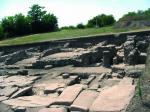Summary (English)
DEULTUM (Hristo Preshlenov – hristo.preshlenov@abv.bg) The explorations of the cardo that run along the thermae continued. It had kerbstones and was 8.40 m wide. Two street pavements of slabs were discovered. During AD 350 – 375, the street colonnade was constructed over bases situated at 3 m from each other. A coin minted in AD 364/378 was found. The second street pavement dated to the end of the 4th century AD. A decumanus, 2.60 – 2.70 m wide and covered with slabs, was constructed to the west of the cardo. During the reconstruction of the adjacent buildings from a fire that occurred after AD 406/408, the level of the cardo was raised and a drain of bricks was constructed. The building to the west of the cardo was built in AD 300 – 350 and was reconstructed in AD 350 – 375. At the end of the 4th century AD the building was reconstructed again. Two hoards with coins were found, minted after AD 367 and after AD 383, respectively. The building was repaired and reconstructed after a fire in the beginning of the 5th century AD. A hoard was found, containing coins of Arcadius and Honorius of AD 395/401, with a latest coin of Arcadius, Honorius and Theodosius II minted in AD 406/408. During the 7th – 8th centuries AD, ramshackle houses were constructed over the debris of the building. At the end of the 4th century AD, another building with an entrance towards the street was constructed to the north of the cardo. The building was repaired and reconstructed after a fire in the beginning of the 5th century AD. During the 6th century AD, a house in rubble masonry was built inside the destroyed building. During the 7th – 8th centuries AD, two buildings were constructed over the debris of the building.
- Hristo Preshlenov - Archaeological Institute with Museum
Director
Team
Research Body
- Archaeological Institute with Museum






![Download [PDF]](/excavation/skins/fasti/images/results/download_sml.png)
